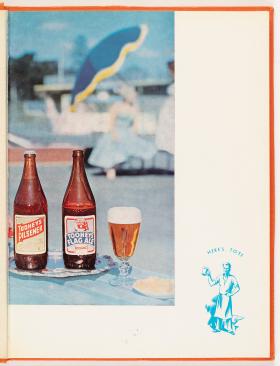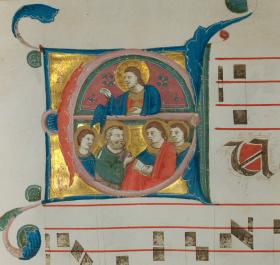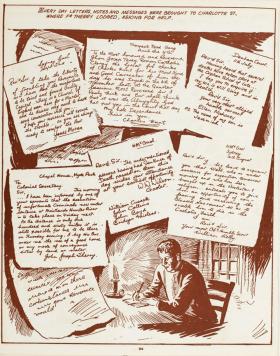The ‘Flying Pieman’, William Francis King (1807-1873), was a legendary fixture on the streets of Sydney during the 1840s.
An actual pieman, King sold his pies around Hyde Park and Circular Quay, but became best known for his ambitious ‘feats of pedestrianism’. These gave him his moniker ‘Flying Pieman’. For anyone even vaguely familiar with Sydney’s geography, it seems extraordinary that he was able to sell his pies to passengers boarding the Sydney to Parramatta ferry, and then run to Parramatta in time to sell any unsold ones to passengers as they disembarked.
A recent addition to the Library’s collection has not only given us the opportunity to brush up on the Pieman’s exploits but see how they might have been represented on stage. Costume and set designs — 21 watercolours in all — for ‘The Flying Pieman — A Ballet Impression of Old Sydney’ by artist Roderick Shaw, have been donated by his daughter, Christine Shaw.
Along with these the colourful designs is an accompanying ballet storyline written by Roderick’s wife, Frances Shaw. The drawings and story together were likely prepared as an entry for a 1942 competition instigated by ballet impresario Wassily de Basil, who brought the Ballet Russes to Australia. The music for the proposed ballet, which was never performed, was composed by Nancy Salas (1910–1990), a significant Sydney musician and music teacher, who performed with Sydney Symphony Orchestra throughout her career. Specialist librarian Meredith Lawn, was able to track down the handwritten musical composition for the ‘Flying Pieman’ ballet from within the Library's Nancy Salas archive, bringing the various elements of this creative endeavour together. In the end, the competition was won by Donald Friend, for a ballet about Ned Kelly.
Born in 1807, William Francis King arrived in Sydney from London in 1829, and worked in various jobs before becoming a pie seller around 1834. From 1842, King’s walking feats became increasingly ambitious, and his renowned pie-selling was soon eclipsed by his athletic adventures. In 1847 the Maitland Mercury and Hunter River General Advertiser reported that King successfully walked ‘one hundred and ninety-two miles in forty-six hours and a half, without resting for a single minute’. He was also known to have beaten the mail coach from Sydney to Windsor, and to have walked from one town to another carrying a goat or a dog, or a 45 kilogram wooden pole. And, of course, for beating the Sydney to Parramatta ferry on foot. His walks often concluded with speeches and proclamations. His exploits were perhaps not so lucrative however, because in 1873 he died destitute at the Liverpool Benevolent Asylum.
The Shaws’ proposed ballet doesn’t delve too deeply into King’s life story or pedestrianism. Instead, it is a simple love story set on the streets of Sydney in 1835, that revolves around a young woman struggling to decide between a conventional romance with a red-coated soldier and the vivid and intriguing ‘Pieman’ who dances in and out of Sydney, living a life without responsibility or care. Roderick Shaw’s designs include one scene set in Macquarie Place, animated with soldiers, sailors, street-nuisances, pickpockets and drunks, street hawkers and young girls, all mingling. It is a hive of activity, not least as the square is the finishing point of the Flying Pieman’s race on foot against the Windsor to Sydney mail coach. Shaw’s lively costume designs show the Pieman in a bright blue and yellow suit jacket and striped blue and white hat — with a pig under one arm!
Artist Roderick Shaw was born at Drummoyne in 1915 and became best known as a social realist painter — he was a member of the Communist Party until 1956 — and a printer of quality, limited-edition books, particularly poetry, under the imprint Edwards and Shaw. He was also a political cartoonist. During WWII, Shaw was a ‘Camoufleur’, or camouflage artist, with the RAAF. He married Frances Cottingham, a JC Williamson actress, in 1938 and were together until her death in 1983.
Given the opportunity, they might have created of one Australia’s most flamboyant, memorable ballets. We’ll never know, but at least now we can see what might have been.





